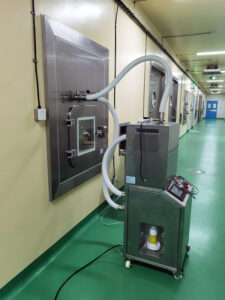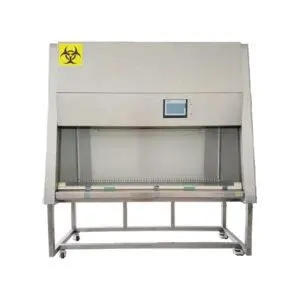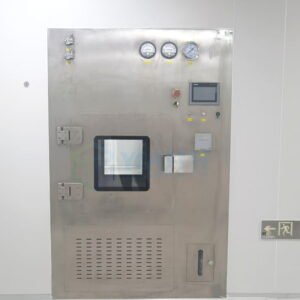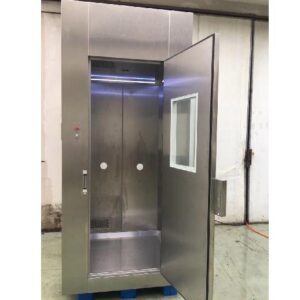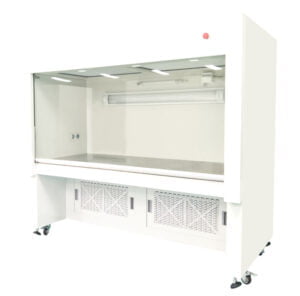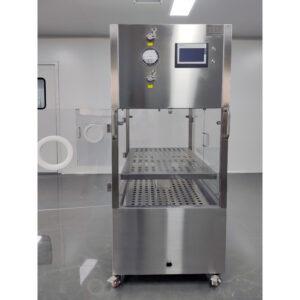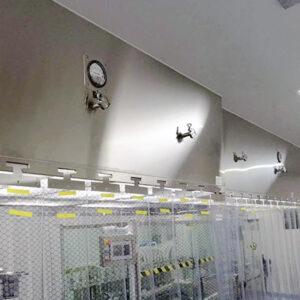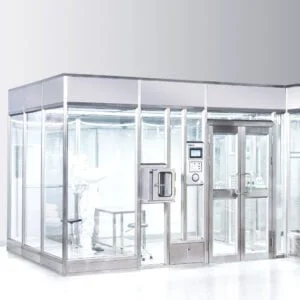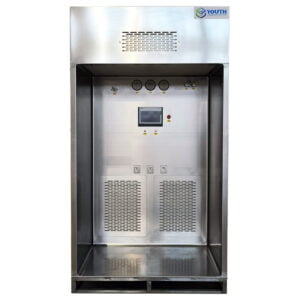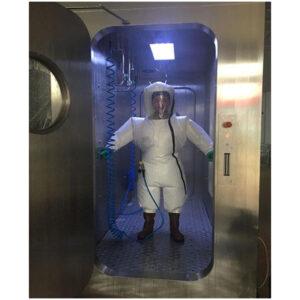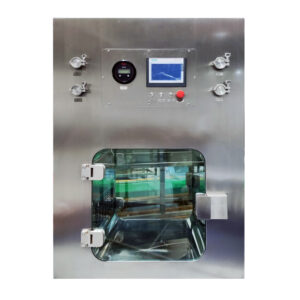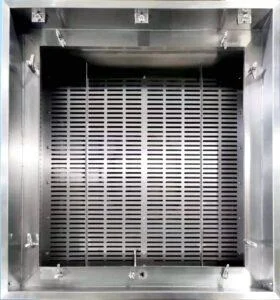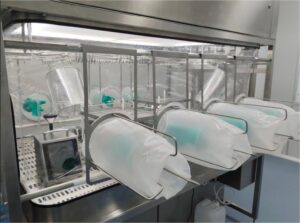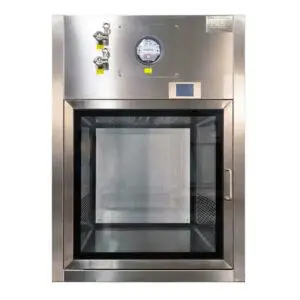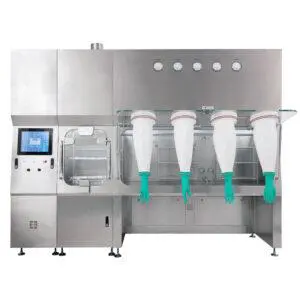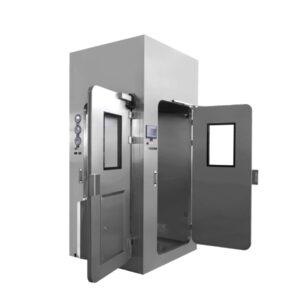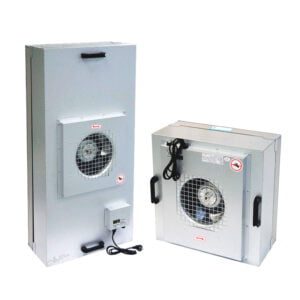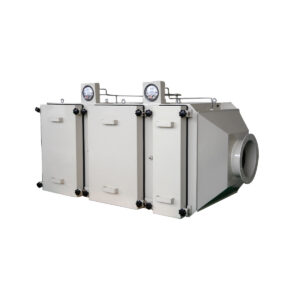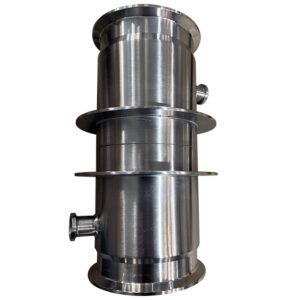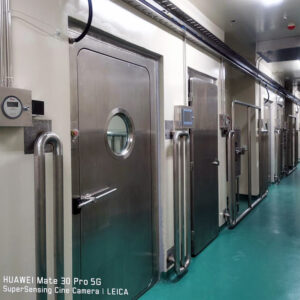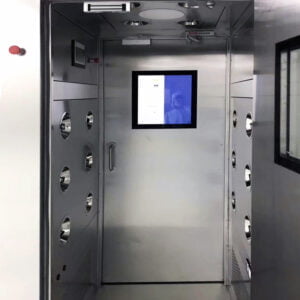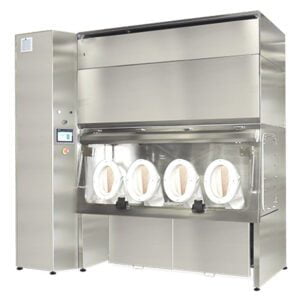In the ever-evolving landscape of pharmaceutical manufacturing, maintaining sterility is paramount. GAMP 5 compliant sterility test isolators have emerged as a critical component in ensuring the integrity of sterile products. These isolators, designed to meet the stringent requirements of Good Automated Manufacturing Practice (GAMP) 5, play a crucial role in preventing contamination and maintaining the highest standards of quality control.
As the pharmaceutical industry continues to advance, the importance of GAMP 5 compliance cannot be overstated. This comprehensive guideline, developed by the International Society for Pharmaceutical Engineering (ISPE), provides a framework for implementing and maintaining computerized systems in regulated environments. For sterility test isolators, adhering to GAMP 5 principles ensures that these critical pieces of equipment are designed, validated, and operated in a manner that consistently meets regulatory requirements and industry best practices.
In this article, we'll delve into the best practices for implementing and maintaining GAMP 5 compliant sterility test isolators. We'll explore the key components of GAMP 5, its application to sterility testing, and the specific considerations that pharmaceutical manufacturers must keep in mind when working with these sophisticated systems. From risk assessment to ongoing maintenance, we'll cover the essential aspects of ensuring your sterility test isolators remain compliant and effective.
GAMP 5 compliance is essential for sterility test isolators to ensure the highest standards of quality, safety, and regulatory adherence in pharmaceutical manufacturing processes.
What are the key principles of GAMP 5 for sterility test isolators?
The foundation of GAMP 5 lies in its core principles, which are particularly relevant when applied to sterility test isolators. These principles guide manufacturers in implementing robust, reliable, and compliant systems that can consistently produce sterile products.
At the heart of GAMP 5 is the concept of a lifecycle approach to computerized systems. This means considering every stage of a sterility test isolator's life, from initial concept and design through to retirement. The guideline emphasizes the importance of risk management, encouraging manufacturers to identify and mitigate potential risks at each stage of the lifecycle.
Another crucial principle is the focus on product and process understanding. For sterility test isolators, this translates to a deep comprehension of the sterility testing process and how the isolator contributes to maintaining sterile conditions. This understanding informs decisions about design, operation, and maintenance of the isolator.
GAMP 5 principles emphasize a risk-based approach, encouraging manufacturers to focus resources on critical aspects of sterility test isolators that directly impact product quality and patient safety.
| GAMP 5 Principle | Application to Sterility Test Isolators |
|---|---|
| Lifecycle Approach | Consider all stages from design to retirement |
| Risk Management | Identify and mitigate risks at each stage |
| Product/Process Understanding | Comprehend sterility testing process thoroughly |
| Critical Thinking | Apply scientific reasoning to isolator design and operation |
In practice, these principles guide manufacturers in developing robust validation plans, implementing effective change control procedures, and maintaining comprehensive documentation. By adhering to these principles, companies can ensure their sterility test isolators not only meet regulatory requirements but also operate at peak efficiency and reliability.
How does risk assessment factor into GAMP 5 compliance for isolators?
Risk assessment is a cornerstone of GAMP 5 compliance, particularly when it comes to sterility test isolators. This process involves identifying, analyzing, and evaluating potential risks associated with the isolator system and its use in sterility testing.
For sterility test isolators, risk assessment begins at the design phase and continues throughout the system's lifecycle. It involves a thorough examination of all aspects of the isolator, from its physical components to its control systems and operating procedures. The goal is to identify any potential points of failure or contamination that could compromise the sterility of the products being tested.
One key aspect of risk assessment for GAMP 5 compliant isolators is the categorization of system components. GAMP 5 defines several categories, ranging from standard off-the-shelf software to custom-developed applications. For sterility test isolators, this might include assessing the risk level of control software, monitoring systems, and any custom interfaces developed for the specific testing process.
Effective risk assessment in GAMP 5 compliance for sterility test isolators helps prioritize validation efforts, focusing resources on high-risk areas that could significantly impact product quality or patient safety.
| Risk Category | Examples in Sterility Test Isolators |
|---|---|
| High Risk | Sterility maintenance systems, air handling units |
| Medium Risk | Temperature and pressure monitoring systems |
| Low Risk | Non-critical data logging systems |
The outcome of this risk assessment informs the validation approach. High-risk components will require more rigorous testing and documentation, while lower-risk elements may be subject to less intensive scrutiny. This risk-based approach ensures that validation efforts are proportionate and focused where they matter most.
By incorporating thorough risk assessment into the GAMP 5 compliance process, manufacturers can develop more robust and reliable sterility test isolators. This not only helps in meeting regulatory requirements but also contributes to overall product quality and patient safety.
What are the validation requirements for GAMP 5 compliant isolators?
Validation is a critical aspect of ensuring GAMP 5 compliance for sterility test isolators. It involves a series of documented tests and checks to prove that the isolator system consistently performs as intended and meets all specified requirements.
The validation process for GAMP 5 compliant isolators typically begins with the development of a validation plan. This plan outlines the scope of validation activities, defines responsibilities, and establishes acceptance criteria. It's important that this plan is comprehensive, covering all aspects of the isolator system that could impact product quality or testing reliability.
Key components of the validation process include Installation Qualification (IQ), Operational Qualification (OQ), and Performance Qualification (PQ). IQ verifies that the isolator is installed correctly and according to specifications. OQ confirms that the isolator operates as intended under normal and stress conditions. PQ demonstrates that the isolator consistently performs as required in its actual operating environment.
GAMP 5 validation for sterility test isolators requires a comprehensive approach that covers all critical aspects of the system, from hardware components to software controls and operating procedures.
| Validation Stage | Key Activities for Sterility Test Isolators |
|---|---|
| IQ | Verify correct installation of HEPA filters, pressure systems |
| OQ | Test air flow patterns, decontamination cycles |
| PQ | Conduct simulated sterility tests, verify consistent performance |
An essential aspect of GAMP 5 compliance is the emphasis on leveraging vendor documentation and testing. This approach, known as "leveraging," can significantly reduce the validation burden on the end-user while still ensuring thorough coverage. For sterility test isolators, this might involve working closely with the isolator manufacturer to understand and utilize their validation data where appropriate.
It's also crucial to remember that validation is not a one-time event. GAMP 5 emphasizes the importance of ongoing performance verification and revalidation when significant changes occur. This ensures that the sterility test isolator remains in a validated state throughout its operational life.
By adhering to these validation requirements, manufacturers can ensure their sterility test isolators are not only GAMP 5 compliant but also consistently reliable in maintaining sterile conditions for critical testing processes.
How does GAMP 5 address software validation for isolator systems?
Software validation is a crucial component of GAMP 5 compliance for sterility test isolators. As these systems often incorporate sophisticated control and monitoring software, ensuring the reliability and accuracy of these programs is paramount to maintaining sterile conditions and producing valid test results.
GAMP 5 provides a structured approach to software validation, which is particularly relevant for the complex systems found in modern sterility test isolators. This approach begins with categorizing the software based on its complexity and criticality. For isolator systems, this might include everything from simple data logging applications to complex environmental control algorithms.
One key principle of GAMP 5 software validation is the concept of "validation by design." This means that quality and compliance considerations are built into the software development process from the very beginning, rather than being addressed as an afterthought. For sterility test isolators, this could involve close collaboration between software developers and microbiologists to ensure that the software accurately reflects the requirements of sterility testing protocols.
GAMP 5 software validation for sterility test isolators emphasizes a risk-based approach, focusing validation efforts on critical functions that directly impact product sterility and test reliability.
| Software Category | Examples in Sterility Test Isolators | Validation Approach |
|---|---|---|
| Infrastructure Software | Operating systems, databases | Typically relies on vendor validation |
| Non-configured Products | Standard monitoring software | Focuses on configuration and integration testing |
| Configured Products | Customized control systems | Requires thorough testing of configuration settings |
| Custom Applications | Bespoke sterility test protocols | Demands comprehensive validation of all functionalities |
GAMP 5 also emphasizes the importance of maintaining a clear audit trail for all software-related activities. This includes documenting any changes or updates to the software, as well as maintaining records of user access and system interactions. For sterility test isolators, this audit trail provides crucial evidence of the system's integrity and can be invaluable during regulatory inspections.
Another important aspect of GAMP 5 software validation is the concept of continuous verification. This involves ongoing monitoring and periodic re-evaluation of the software to ensure it continues to meet requirements and perform as expected. For sterility test isolators, this might include regular checks of data integrity, system performance, and alignment with current Good Manufacturing Practice (cGMP) requirements.
By following GAMP 5 guidelines for software validation, manufacturers can ensure that the software components of their sterility test isolators are robust, reliable, and compliant with regulatory expectations. This not only supports GAMP 5 compliance but also contributes to the overall quality and reliability of the sterility testing process.
What are the best practices for maintaining GAMP 5 compliance in isolators?
Maintaining GAMP 5 compliance for sterility test isolators is an ongoing process that requires vigilance, commitment, and a structured approach. Best practices in this area focus on continuous monitoring, regular review, and proactive management of the isolator system.
One of the key best practices is the implementation of a robust change control process. Any changes to the isolator system, whether hardware or software, should be carefully evaluated for their potential impact on system performance and compliance. This includes assessing the need for revalidation after significant changes and ensuring that all modifications are thoroughly documented.
Regular system reviews are another crucial aspect of maintaining GAMP 5 compliance. These reviews should assess the ongoing performance of the isolator, evaluate any trends or issues that have arisen, and consider whether the current validation status remains appropriate. For sterility test isolators, this might involve reviewing environmental monitoring data, assessing the frequency and nature of any sterility test failures, and evaluating the effectiveness of decontamination procedures.
Maintaining GAMP 5 compliance for sterility test isolators requires a proactive approach, with regular reviews, robust change control, and ongoing training to ensure the system remains fit for purpose and compliant with current regulations.
| Maintenance Activity | Frequency | Key Considerations |
|---|---|---|
| System Performance Review | Quarterly | Analyze trends in environmental data |
| Change Control Assessment | As needed | Evaluate impact of proposed changes |
| User Training | Annually | Ensure operators understand current procedures |
| Regulatory Update Review | Bi-annually | Assess impact of new guidelines or regulations |
Training is another critical component of maintaining GAMP 5 compliance. All personnel involved in operating or maintaining the sterility test isolator should receive regular training on current procedures, any system updates, and the importance of maintaining sterile conditions. This training should be documented and its effectiveness regularly assessed.
YOUTH emphasizes the importance of documentation in maintaining GAMP 5 compliance. This includes keeping detailed records of all maintenance activities, calibrations, and any deviations from standard operating procedures. For sterility test isolators, this documentation provides crucial evidence of the system's ongoing compliance and can be invaluable during audits or regulatory inspections.
Finally, staying up-to-date with evolving regulatory requirements and industry best practices is essential. This might involve regular attendance at industry conferences, participation in professional networks, or engagement with regulatory bodies. By staying informed, manufacturers can ensure their sterility test isolators remain compliant with the latest GAMP 5 interpretations and expectations.
By adhering to these best practices, manufacturers can ensure their sterility test isolators remain GAMP 5 compliant throughout their operational life, supporting the production of safe, high-quality sterile products.
How does GAMP 5 compliance impact the design of sterility test isolators?
GAMP 5 compliance has a significant influence on the design of sterility test isolators, shaping everything from the physical construction to the control systems and user interfaces. This impact begins at the conceptual stage and continues through detailed design and implementation.
One of the primary ways GAMP 5 impacts isolator design is through its emphasis on risk management. Designers must consider potential risks at every stage of the isolator's lifecycle, from initial installation to routine operation and maintenance. This risk-based approach often leads to design features that minimize contamination risks, such as smooth, easily cleanable surfaces, robust air handling systems, and fail-safe mechanisms for critical functions.
The GAMP 5 principle of leveraging supplier expertise also influences isolator design. Manufacturers often work closely with suppliers to incorporate pre-validated components or systems, reducing the validation burden while ensuring high-quality, reliable performance. This collaboration can lead to innovative design solutions that meet both regulatory requirements and practical operational needs.
GAMP 5 compliance drives the design of sterility test isolators towards greater reliability, easier validation, and enhanced user safety, ultimately contributing to more consistent and dependable sterility testing processes.
| Design Aspect | GAMP 5 Influence | Example Feature |
|---|---|---|
| Materials | Emphasis on cleanability | Use of electropolished stainless steel |
| Control Systems | Focus on data integrity | Secure, audit-trailed software interfaces |
| User Interface | Consideration of human factors | Intuitive, error-reducing control panels |
| Maintenance Access | Design for serviceability | Easy-access panels for critical components |
GAMP 5's focus on the entire system lifecycle also impacts isolator design. Designers must consider not just the initial installation and qualification, but also ongoing operation, maintenance, and eventual decommissioning. This lifecycle approach often results in designs that are more modular, easier to maintain, and simpler to upgrade over time.
Another key aspect of GAMP 5 that influences isolator design is the emphasis on critical thinking and scientific understanding. Designers must have a deep understanding of microbiology and sterility testing processes to create isolators that truly meet the needs of end-users. This often leads to innovative features that enhance sterility assurance, such as advanced air flow patterns or integrated rapid microbial detection systems.
The GAMP 5 compliance requirements also drive the integration of robust monitoring and control systems. These systems must not only maintain the required environmental conditions but also provide reliable, tamper-proof data recording to support regulatory compliance. This often results in the incorporation of advanced sensors, real-time monitoring capabilities, and secure data management systems into the isolator design.
By considering GAMP 5 compliance from the earliest stages of design, manufacturers can create sterility test isolators that are not only compliant with current regulations but also more efficient, reliable, and future-proof. This approach ultimately contributes to higher quality sterility testing and greater confidence in the safety of sterile pharmaceutical products.
What role does documentation play in GAMP 5 compliance for isolators?
Documentation plays a crucial role in demonstrating and maintaining GAMP 5 compliance for sterility test isolators. Comprehensive, accurate, and up-to-date documentation is not just a regulatory requirement; it's a fundamental tool for ensuring the ongoing reliability and compliance of these critical systems.
The documentation requirements for GAMP 5 compliant isolators cover every stage of the system lifecycle, from initial design specifications through to operational procedures and eventual decommissioning. This "cradle-to-grave" approach ensures that there's a clear, auditable trail of evidence demonstrating the isolator's compliance at every stage.
One of the key documents in GAMP 5 compliance is the Validation Master Plan (VMP). This high-level document outlines the overall validation strategy for the isolator, including the scope of validation activities, roles and responsibilities, and key acceptance criteria. For sterility test isolators, the VMP would typically include considerations specific to maintaining sterile conditions and ensuring reliable test results.
Comprehensive and accurate documentation is the backbone of GAMP 5 compliance for sterility test isolators, providing evidence of proper design, validation, and ongoing performance throughout the system's lifecycle.
| Document Type | Purpose | Key Contents for Sterility Test Isolators |
|---|---|---|
| User Requirements Specification | Define system needs | Sterility maintenance parameters, testing protocols |
| Design Specification | Detail system design | Air handling system design, decontamination processes |
| Validation Protocols | Outline testing procedures | IQ/OQ/PQ test plans, acceptance criteria |
| Standard Operating Procedures | Guide routine operation | Aseptic techniques, environmental monitoring procedures |
| Change Control Records | Document system modifications | Impact assessments, revalidation requirements |
Another critical set of documents are the validation protocols and reports. These documents provide detailed evidence that the isolator has been thoroughly tested and proven to meet all specified requirements. For sterility test isolators, this would include documentation of tests to verify the maintenance of sterile conditions, the effectiveness of decontamination procedures, and the reliability of environmental monitoring systems.
Standard Operating Procedures (SOPs) are also a key component of GAMP 5 documentation. These documents provide step-by-step instructions for all aspects of isolator operation, from routine use to maintenance and troubleshooting. For sterility test isolators, SOPs would typically cover topics such as aseptic technique, environmental monitoring, and response procedures for out-of-specification results.
GAMP 5 also emphasizes the importance of maintaining a clear audit trail for all system activities. This includes documenting any changes to the system, whether hardware or software, as well as recording routine operations and maintenance activities. For sterility test isolators, this audit trail provides crucial evidence of the system's ongoing compliance and can be invaluable during regulatory inspections.
It's important to note that in the context of GAMP 5, documentation is not a static, one-time activity. Instead, it's an ongoing process that requires regular review and updates to ensure it remains accurate and relevant. This might involve periodic reviews of SOPs, updates to risk assessments based on operational experience, or revisions to validation documentation in response to system changes.
By maintaining comprehensive and up-to-date documentation, manufacturers can not only demonstrate GAMP 5 compliance for their sterility test isolators but also support ongoing quality management, facilitate troubleshooting, and enable continuous improvement of their sterility testing processes.
Conclusion
In conclusion, GAMP 5 compliant sterility test isolators represent a critical intersection of advanced technology, rigorous quality control, and regulatory compliance in the pharmaceutical industry. By adhering to GAMP 5 principles, manufacturers can ensure that these essential systems are designed, validated, and operated in a manner that consistently meets the highest standards of quality and reliability.
The best practices we've explored in this article – from risk-based design and thorough validation to ongoing maintenance and comprehensive documentation – form a robust framework for implementing and maintaining GAMP 5 compliant isolators. These practices not only support regulatory compliance but also contribute to the overall efficiency and effectiveness of sterility testing processes.
As the pharmaceutical landscape continues to evolve, with increasing emphasis on data integrity, automation, and risk management, the principles of GAMP 5 will remain crucial in guiding the development and use of sterility test isolators. By staying committed to these principles, manufacturers can ensure their isolators remain at the forefront of quality and compliance, ultimately contributing to the production of safer, higher-quality sterile pharmaceutical products.
The journey to GAMP 5 compliance is ongoing, requiring constant vigilance, adaptation, and improvement. However, by embracing these challenges, manufacturers can turn compliance into a competitive advantage, driving innovation and excellence in sterility testing and pharmaceutical manufacturing as a whole.
External Resources
GAMP 5 for GxP Compliant Computerized Systems – Scilife – This article explains the GAMP 5 guideline, its key principles, and its application in designing, developing, and maintaining computerized systems in GxP-regulated environments. It emphasizes the importance of product and process knowledge and risk-based testing.
Mastering GAMP5: A Comprehensive How-to Guide for Everyone – Pharmuni – This guide provides a detailed overview of GAMP5, including its role in computer system validation, categories of systems (such as Software Applications, Process Control Systems, and GMP Ancillary Systems), and the importance of a risk-based approach in validation planning.
Compliance with GAMP 5 guidance: A checklist – Tricentis – This resource offers a comprehensive checklist for GAMP 5 compliance, covering aspects such as vendor selection, functional and design specifications, user requirements, verification and testing, operational controls, and contracts with software vendors.
GAMP 5 guidelines and the FDA's CSA guidance – Ideagen – This article discusses how GAMP 5 guidelines and the FDA's Draft Guidance on Computer Software Assurance (CSA) work together to ensure regulatory compliance, high quality, and suitability for GxP applications, emphasizing a balanced approach to validation and assurance.
GAMP5: A Risk-Based Approach to Automated Systems – ISPE – This is the official ISPE resource on GAMP5, providing detailed guidance on the risk-based approach for validating and controlling automated systems in the pharmaceutical and medical device industries.
GAMP 5 Compliance: Ensuring Quality and Regulatory Adherence – Pharmaceutical Technology – This article focuses on the practical implementation of GAMP 5, highlighting its importance in ensuring quality, regulatory adherence, and patient safety in the life sciences industry.
Related Contents:
- cGMP Compliant Sterility Test Isolators: Key Features
- Medical Device Testing with Sterility Test Isolators
- Compact Sterility Test Isolators for Small Labs
- Radiopharmaceutical Sterility Testing: Isolator Guide
- USP <797> Compliant Sterility Test Isolators: Essentials
- Sterility Test Isolators for Ophthalmic Products
- Custom Sterility Test Isolators: Top 5 Designs 2025
- Sterile Antibiotic Testing: Isolator Techniques
- Flexible Wall Isolators: Cost-Effective Sterility Testing


